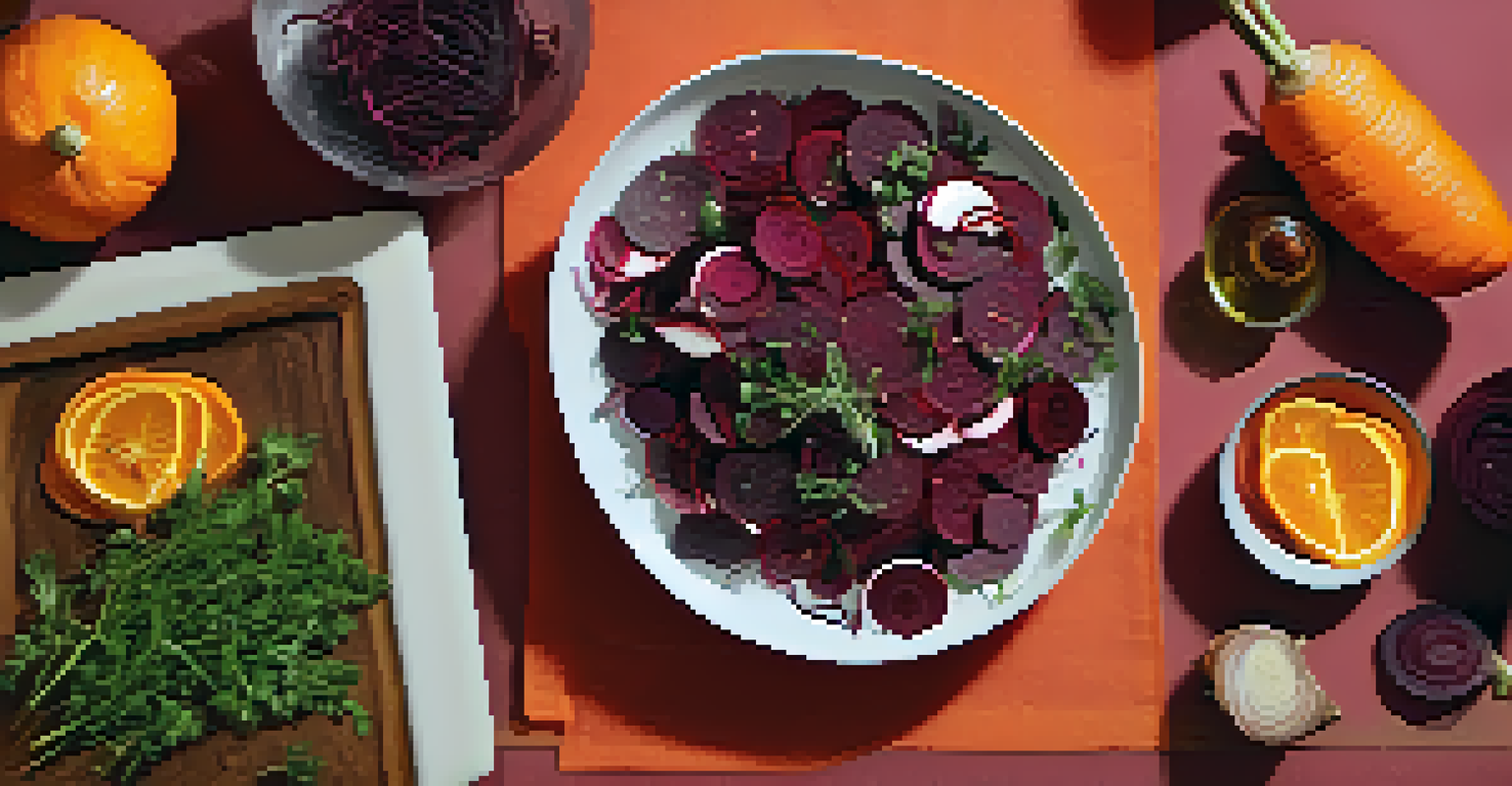Seasonal Produce: Adjusting Your Raw Food Diet Year-Round

Understanding the Importance of Seasonal Produce
Eating seasonally means choosing fruits and vegetables that are harvested at their peak. This not only enhances the flavors and nutritional value but also supports local farmers and reduces carbon footprints. When you consume in-season produce, you're enjoying food that's fresher and often more affordable.
Eat food, not much, mostly plants.
For example, summer brings a bounty of juicy tomatoes and sweet peaches, while winter offers hearty root vegetables like carrots and beets. By aligning your diet with the seasons, you can enjoy a diverse array of flavors and textures throughout the year. Plus, it keeps your meals interesting and varied.
Ultimately, embracing seasonal produce is about connecting with nature and the cycles of growth. It's a simple yet impactful way to ensure that your raw food diet remains vibrant and nutritious, no matter the time of year.
Spring Delights: Fresh Greens and Blossoms
As winter fades, spring ushers in a palette of vibrant greens and delicate blossoms. Think fresh spinach, arugula, and edible flowers like nasturtiums, which not only add color but also flavor to your dishes. Incorporating these springtime treasures into your raw meals can create a refreshing and invigorating experience.

Consider a spring salad bursting with mixed greens, sliced radishes, and a sprinkle of edible flowers. This not only looks beautiful but also provides a range of nutrients essential for revitalizing your body after the colder months. The crispness of these vegetables can awaken your palate and inspire creativity in your meal planning.
Embrace Seasonal Eating Benefits
Eating seasonally enhances flavor, supports local farmers, and reduces carbon footprints.
Additionally, spring is a fantastic time to experiment with raw soups or smoothies using seasonal produce. Blend fresh greens with fruits like strawberries or bananas for a nutrient-packed drink that captures the essence of spring.
Summer Joy: Berries, Stone Fruits, and More
Summer is a celebration of color and flavor, with an abundance of berries and stone fruits at their peak. Blueberries, raspberries, peaches, and cherries are not only delicious but also packed with antioxidants. These fruits can be enjoyed as snacks, blended into smoothies, or added to salads for a sweet twist.
The best way to know the quality of your food is to know your farmer.
Imagine a summer breakfast featuring a refreshing bowl of mixed berries topped with raw granola and a drizzle of agave syrup. This simple dish showcases the vibrant flavors of the season while providing a healthy start to your day. The natural sweetness of these fruits can satisfy cravings without needing added sugars.
Don't forget about summer vegetables like zucchini and cucumbers, which can be spiralized into raw noodles or used in salads. The versatility of summer produce allows for endless creativity in your raw food diet, making it easy to stay cool and nourished during the warm months.
Autumn Abundance: Root Vegetables and Squash
As autumn arrives, the focus shifts to hearty root vegetables and squashes. Carrots, sweet potatoes, and butternut squash are excellent choices for adding substance to your raw meals. These vegetables can be spiralized, julienned, or thinly sliced to create satisfying salads or snacks.
For example, a raw carrot and beet salad dressed with lemon and olive oil can be both colorful and nutritious. The earthy flavors of these vegetables combined with zesty dressing create a delightful contrast that warms your soul. Autumn is also a great time to explore fermentation, as root veggies make excellent candidates for pickling.
Plan Your Seasonal Raw Menu
Creating a seasonal raw food menu allows for creativity, variety, and exploration of new ingredients.
Moreover, incorporating seasonal spices like cinnamon and nutmeg can enhance the flavors of your dishes, bringing the essence of fall right to your plate. Embracing the harvest season allows you to enjoy the rich, comforting flavors of autumn while maintaining your commitment to raw foods.
Winter Wellness: Citrus Fruits and Greens
During the colder months, citrus fruits like oranges, grapefruits, and lemons become a staple in many raw diets. These fruits are not only refreshing but also packed with vitamin C, which is crucial for boosting your immune system during flu season. Adding slices of citrus to salads or smoothies can brighten up even the dreariest winter days.
In addition to citrus, hearty greens like kale and collard greens thrive in winter. These greens can be massaged with a bit of olive oil and lemon to soften their texture, making them perfect for salads. Pairing them with nuts or seeds can add a satisfying crunch and healthy fats to your meal.
Winter is also a time for cozying up with warming soups. While traditional soups are cooked, you can create raw versions using blended vegetables and spices, providing a comforting yet nutritious meal. Embracing winter produce ensures you stay nourished while enjoying the unique flavors of the season.
Planning Your Seasonal Raw Food Menu
Creating a seasonal raw food menu can be both fun and rewarding. Start by researching what produce is in season in your area, and make a list of your favorites. This approach not only helps you save money but also encourages you to explore new ingredients and recipes throughout the year.
Consider setting aside a few hours each week to plan meals that highlight seasonal offerings. For instance, if you know zucchini is in season, you might plan for zucchini noodles or a raw zucchini salad. This intentional planning can bring excitement and variety to your raw food diet.
Connect with Community Through Food
Sourcing local produce fosters community connections and enhances appreciation for sustainable eating.
Don't hesitate to visit local farmers' markets where you can discover the freshest seasonal produce and support your community. Engaging with local growers can also ignite new ideas for your meals, making the journey of eating seasonally even more enjoyable.
Storing Seasonal Produce for Maximum Freshness
Proper storage of seasonal produce is key to maintaining freshness and flavor. Many fruits and vegetables have specific storage needs; for example, leafy greens do best in a breathable container in the fridge, while tomatoes thrive at room temperature. Understanding these needs can help you minimize waste and enjoy your produce for longer.
Additionally, consider freezing or dehydrating excess produce when it’s in season. This way, you can enjoy the taste of summer berries or autumn squash even in the depths of winter. It’s a great way to extend the life of your favorite seasonal ingredients and make meal prep easier.

Lastly, always inspect your produce before storing it. Remove any damaged items to prevent spoilage from spreading. By taking these simple steps, you can ensure that your seasonal produce stays fresh and delicious, providing you with the best quality for your raw food meals.
Connecting with Community Through Seasonal Eating
Eating seasonally isn't just about food; it's about building connections within your community. By sourcing produce from local farmers or joining a community-supported agriculture (CSA) program, you become part of a network that values sustainability and fresh ingredients. This connection can enhance your appreciation for the food you consume.
In addition, consider sharing meals or recipes with friends and family that highlight seasonal produce. Hosting a potluck where everyone brings a dish made from in-season ingredients can create a sense of camaraderie while celebrating the flavors of each season. It's a wonderful way to inspire others to embrace seasonal eating.
Ultimately, connecting with your community through food can lead to a greater understanding of where your food comes from and the impact of your choices. As you adjust your raw food diet year-round, remember that each meal is an opportunity to nourish not only yourself but also the relationships in your life.